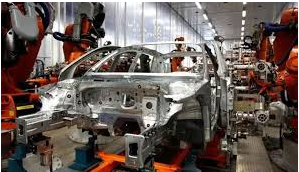INP-WealthPk
Qudsia Bano
Pakistan’s industrial sector continued to gain strength during the first quarter of FY2026 as large-scale manufacturing (LSM) posted 4.4 percent growth, led by strong performance in automobiles, construction materials, and electrical goods.
According to the Finance Division’s Monthly Economic Update & Outlook (October 2025), twelve major sectors recorded growth during July–August FY2026, including wearing apparel, non-metallic mineral products, food, electrical equipment, automobiles, and tobacco.
In August 2025 alone, LSM grew 0.5 percent year-on-year, although month-on-month output declined by 2.7 percent due to temporary supply constraints and seasonal adjustments.
The automobile sector performed exceptionally well, with production of cars up 74 percent, trucks and buses up 105 percent, and jeeps and pickups up 48.7 percent during July–September. The surge was attributed to improved supply chains, lower import restrictions, and rising consumer demand.
The construction industry also showed robust momentum. Cement dispatches increased 16.2 percent to 12.2 million tonnes during Q1-FY2026, with domestic consumption up 15.1 percent and exports up 20.8 percent to 2.6 million tonnes.
The Finance Division said these indicators reflected renewed confidence in Pakistan’s manufacturing base, supported by improved energy availability, policy stability, and moderate inflation. “Industrial recovery continues to anchor the overall growth trajectory,” the report said.
Other industries showing notable improvement included food processing, apparel, and tobacco manufacturing. Increased demand in domestic and export markets supported capacity utilization, particularly in garments and knitwear, which have maintained strong export performance.
Economists said the sustained LSM recovery signals the early stages of industrial rebound after several years of sluggish activity. “This momentum, if maintained, can translate into job creation and higher tax revenue,” one analyst noted.
The Finance Division emphasized that the industrial upturn was accompanied by steady growth in private sector credit, which empowered firms to boost working capital and invest in modernization. Improved business confidence and stable macroeconomic conditions also contributed to higher output levels.
The report projected that industrial growth would continue in the coming quarters, driven by automotive demand, construction projects, and export-linked sectors. “The momentum in large-scale manufacturing will remain a key pillar of GDP growth during FY2026,” it concluded.

Credit: INP-WealthPk













